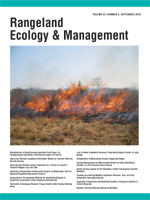Remote sensing is used to map the actual distribution of some invasive plant species, such as leafy spurge (Euphorbia esula L.), whereas geospatial models are used to indicate the species' potential distribution over a landscape. Geographic data layers were acquired for Crook County, Wyoming, and the potential distribution of leafy spurge presence or absence were predicted with the use of the Weed Invasion Susceptibility Prediction (WISP) model. Hyperspectral imagery and field data were acquired in 1999 over parts of the study area. Leafy spurge presence or absence was classified with the use of the Spectral Angle Mapper with a 74% overall accuracy. However, the user accuracy was 93%, showing that where leafy spurge was indicated in the image, leafy spurge was usually found at that location. With the use of Kappa analysis, there was no agreement between WISP model predictions and either the field data or the classified hyperspectral image. Kappa analysis was then used to compare predictions based on single geographic data layers, to increase the power to detect subtle relationships between independent variables and leafy spurge distribution. The WISP model was revised for leafy spurge based on the remote-sensing analyses, and only a few variables contributed to predictions of leafy spurge distribution. The revised model had significantly increased accuracy, from 52.8% to 61.3% for the field data and from 30.4% to 80.3% for the hyperspectral image classification, primarily by reducing the areas predicted to have potential for invasion. It is generally more cost effective to deal with the initial stages of invasion by only a few plants, compared to an invasion that is large enough to be detected by remote sensing. By reducing the potential area for monitoring, management of invasive plants could be performed more efficiently by field crews.
How to translate text using browser tools
1 September 2010
Improving Potential Geographic Distribution Models for Invasive Plants by Remote Sensing
E. Raymond Hunt,,
John H. Gillham,
Craig S. T. Daughtry
AVIRIS
Euphorbia esula
hyperspectral remote sensing
Kappa analysis
leafy spurge
Weed Invasion Susceptibility Prediction model





